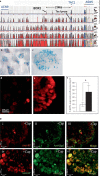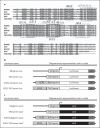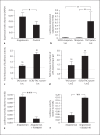Long-range regulatory synergy is required to allow control of the TAC1 locus by MEK/ERK signalling in sensory neurones
- PMID: 21160161
- PMCID: PMC3718575
- DOI: 10.1159/000322010
Long-range regulatory synergy is required to allow control of the TAC1 locus by MEK/ERK signalling in sensory neurones
Abstract
Changes in the expression of the neuropeptide substance P (SP) in different populations of sensory neurones are associated with the progression of chronic inflammatory disease. Thus, understanding the genomic and cellular mechanisms driving the expression of the TAC1 gene, which encodes SP, in sensory neurones is essential to understanding its role in inflammatory disease. We used a novel combination of computational genomics, primary-cell culture and mouse transgenics to determine the genomic and cellular mechanisms that control the expression of TAC1 in sensory neurones. Intriguingly, we demonstrated that the promoter of the TAC1 gene must act in synergy with a remote enhancer, identified using comparative genomics, to respond to MAPK signalling that modulates the expression of TAC1 in sensory neurones. We also reveal that noxious stimulation of sensory neurones triggers this synergy in larger diameter sensory neurones--an expression of SP associated with hyperalgesia. This noxious stimulation of TAC1 enhancer-promotor synergy could be strongly blocked by antagonism of the MEK pathway. This study provides a unique insight into the role of long-range enhancer-promoter synergy and selectivity in the tissue-specific response of promoters to specific signal transduction pathways and suggests a possible new avenue for the development of novel anti-inflammatory therapies.
Copyright © 2010 S. Karger AG, Basel.
Figures





Similar articles
-
Evidence for regulatory diversity and auto-regulation at the TAC1 locus in sensory neurones.J Neuroinflammation. 2011 Feb 4;8:10. doi: 10.1186/1742-2094-8-10. J Neuroinflammation. 2011. PMID: 21294877 Free PMC article.
-
Functional effects of polymorphisms on glucocorticoid receptor modulation of human anxiogenic substance-P gene promoter activity in primary amygdala neurones.Psychoneuroendocrinology. 2014 Sep;47(100):43-55. doi: 10.1016/j.psyneuen.2014.04.017. Epub 2014 May 2. Psychoneuroendocrinology. 2014. PMID: 25001955 Free PMC article.
-
A proximal E-box modulates NGF effects on rat PPT-A promoter activity in cultured dorsal root ganglia neurones.Neuropeptides. 2005 Oct;39(5):475-83. doi: 10.1016/j.npep.2005.08.004. Epub 2005 Sep 29. Neuropeptides. 2005. PMID: 16198417
-
A remote and highly conserved enhancer supports amygdala specific expression of the gene encoding the anxiogenic neuropeptide substance-P.Mol Psychiatry. 2006 Apr;11(4):323, 410-21. doi: 10.1038/sj.mp.4001818. Mol Psychiatry. 2006. PMID: 16402133
-
c-Src kinase activation regulates preprotachykinin gene expression and substance P secretion in rat sensory ganglia.Eur J Neurosci. 2003 Oct;18(7):1719-30. doi: 10.1046/j.1460-9568.2003.02878.x. Eur J Neurosci. 2003. PMID: 14622206
Cited by
-
An analysis of possible off target effects following CAS9/CRISPR targeted deletions of neuropeptide gene enhancers from the mouse genome.Neuropeptides. 2017 Aug;64:101-107. doi: 10.1016/j.npep.2016.11.003. Epub 2016 Nov 4. Neuropeptides. 2017. PMID: 27866656 Free PMC article.
-
Analysis of the effects of depression associated polymorphisms on the activity of the BICC1 promoter in amygdala neurones.Pharmacogenomics J. 2016 Aug;16(4):366-74. doi: 10.1038/tpj.2015.62. Epub 2015 Oct 6. Pharmacogenomics J. 2016. PMID: 26440730 Free PMC article.
-
Allele-specific differences in activity of a novel cannabinoid receptor 1 (CNR1) gene intronic enhancer in hypothalamus, dorsal root ganglia, and hippocampus.J Biol Chem. 2012 Apr 13;287(16):12828-34. doi: 10.1074/jbc.M111.336750. Epub 2012 Feb 23. J Biol Chem. 2012. PMID: 22362764 Free PMC article.
-
An ancient polymorphic regulatory region within the BDNF gene associated with obesity modulates anxiety-like behaviour in mice and humans.Mol Psychiatry. 2024 Mar;29(3):660-670. doi: 10.1038/s41380-023-02359-7. Epub 2024 Jan 16. Mol Psychiatry. 2024. PMID: 38228888 Free PMC article.
-
SVA retrotransposons as modulators of gene expression.Mob Genet Elements. 2014 Jul 24;4:e32102. doi: 10.4161/mge.32102. eCollection 2014. Mob Genet Elements. 2014. PMID: 25077041 Free PMC article.
References
-
- Geppetti P, Nassini R, Materazzi S, Benemei S. The concept of neurogenic inflammation. BJU Int. 2008;101(Suppl 3):2–6. - PubMed
-
- Cao YQ, Mantyh PW, Carlson EJ, Gillespie AM, Epstein CJ, Basbaum AI. Primary afferent tachykinins are required to experience moderate to intense pain. Nature. 1998;392:390–394. - PubMed
-
- Hokfelt T, Pernow B, Wahren J. Substance p: a pioneer amongst neuropeptides. J Intern Med. 2001;249:27–40. - PubMed
Publication types
MeSH terms
Substances
Grants and funding
LinkOut - more resources
Full Text Sources
Miscellaneous

